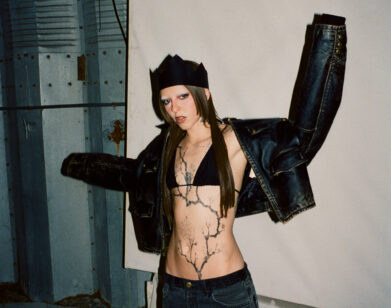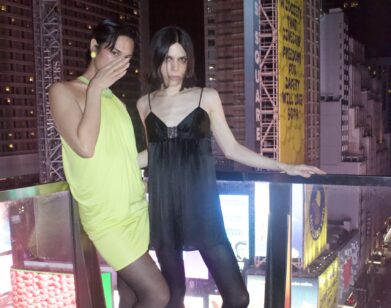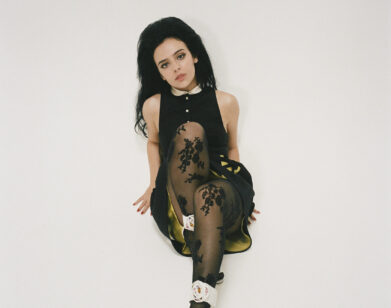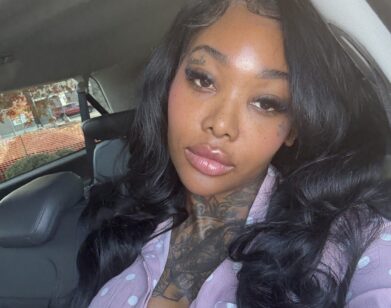Factory Floor, In Full
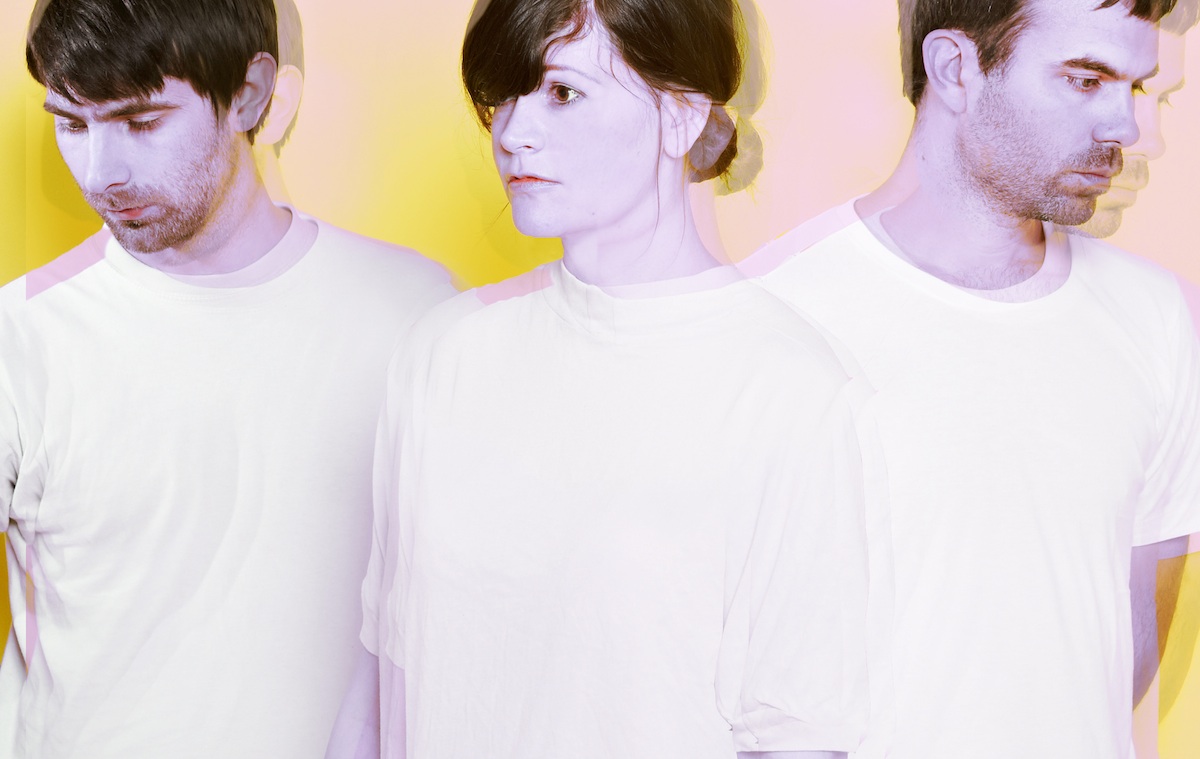
ABOVE: FACTORY FLOOR
Reviews of British electronic outfit Factory Floor point to the band’s “post-industrial” and “post-punk” influences, but those descriptions imply that the band is building its sound from the past. Instead, the band’s self-titled debut focuses on stripping down and deconstructing sound itself. Throughout the album, the mood is cold, deliberate, and razor-sharp. The tracks are intensely repetitious, with each note ringing out as though through a vacuum. “Our live show is very full and has a different type of energy,” says vocalist/guitarist Nik Colk Void. “But during our studio practice we wanted to minimalize it. It’s kind of a clinical version of what Factory Floor is live.”
Even the vocals, which are heavily processed, contain little in the way of human warmth. “Vocals to me have always been more about the sound than what they’re actually saying,” says Void, whose lyrics are purposefully oblique. “I also enjoy the play of the production, manipulating [the vocals], and covering the words—using it more of a rhythmical instrument rather than it being the focus.”
Originally founded in 2005, the band has changed lineups and evolved since its early days. Now officially a three piece since 2009 (members include drummer Gabe Gurnsey, Dominic Butler on synths, and the aforementioned Void), the band has just released its first album via DFA Records. Interview caught up with Factory Floor just before the LP’s release via Skype from their North London warehouse to talk working with DFA, advice from Throbbing Gristle, and the role repetition plays in its music.
NATHAN REESE: The debut record has been a long time coming. How does it feel to finally have the LP out so many years after the project started?
GABE GURNSEY: It’s been a quite a hectic couple of years, but we’re not just sitting around twiddling our thumbs. We’ve been really busy doing a lot of shows and developing our sound on stage. And setting up a recording studio so we could spend time in here doing our album and learning how to produce and record and write our own records. So there’s been a lot of process in it, and it feels great for it to be finally on vinyl and released.
REESE: You’re releasing the album on DFA. How did you hook up with the label, and what is like working with them?
NIK COLK VOID: I think [DFA label manager] Jonathan Galkin just heard a demo—it was passed to him. He got in contact and said that he’d like to release it as a single. We were really happy about that. Moving from East London to North London was a way for us to escape what was going on in London musically. We wanted to be in our own bubble. So to be invited to be on a label in New York seemed to make sense to us, rather than being on a being on a label in the U.K. So he released that single and then another single, so it seemed the right path to put the album out with him.
REESE: What sort of feedback did you get from the label as you were writing the album?
VOID: He’s flown over here and stayed with us in the studio on one occasion, but most of the time he just leaves us to it. They’re quite vocal in what we send over, whether they feel that we’ve gone too far with the process—which is always good when you record on your own, because you can take things too far. You polish it up too much. He’s able to direct us a little bit in that way, which is quite unusual for a record label. It’s been really positive, hasn’t it?
GURNSEY: Yeah, definitely. It’s been quite a natural kind of build. We’ve developed it in our own time. It’s been good for us. I think that’s the only way you can do it, really.
REESE: Typically, what’s the process like when you start to write a song together?
DOMINIC BUTLER: I think a lot of the ideas originate in the live performance setting when we’re doing shows. We do a lot of improvisation in our set, and I think we’re kind of in tune with that way of working and how it can grow. [We come up with] ideas that you wouldn’t come across in a studio, maybe. If you try to pre-conceive an idea too much, it can take a lot of the life out of it. In a live set, you’re acting completely on instinct. We’ve learned that it’s a really way of staring an idea for a track and then revisiting it back in the warehouse. We then work on them quite a lot from that point. They go on quite a journey, really, of editing, replaying.
REESE: Speaking of live shows, what setting do you most enjoying playing? I know that you’ve had a lot of experience in non-traditional settings.
VOID: My favorite place is small warehouse spaces. Being able to take in our own sound system. Having the freedom to set up how we’d like. We all like to set up in the center and have the audience surround us to dismantle the idea of doing a performance for the audience. We’d rather have the audience kind of within our sound.
GURNSEY: We like to engulf everyone, including us. Surround everyone in the sound, so everyone’s at the same level and the same height. We’re not up on the stage and people are watching. It’s nice to let everyone come and get lost in it, and see what we’re doing as far as creating it. We feel like part of the audience when we’re physically on the same level as them. It just creates more energy in the room, and I think we really feed off of that.
BUTLER: Yeah, I think that inclusiveness of an audience is really important to us. You can play shows where there’s a detachment and you really have to work to build a bridge. Ideally, we really take that into account. Especially if we’re curating our own shows and we have the freedom to say, “This is how we want to do it. This is what we’re after.”
REESE: You’ve had the opportunity to work with some amazing people, including Joy Division drummer Stephen Morris and members of Throbbing Gristle. What have you learned that’s been the most helpful to your own music?
BUTLER: It just reassured us that we were doing was right. We haven’t studied music production or anything like that. We’ve come from a very idiosyncratic kind of approach. We do it how we’ve learned from experimentation. To work with people who have made some great records and find out that they have a similar approach just reassures you that you can accomplish what you want through your own way.
VOID: Cosey Fanni Tutti [of Throbbing Gristle] said to me—because we did these improvised shows and were a little bit unsure—”Don’t be nervous, because all you’re going to do is make a mistake, and that’s going to go by very quickly. It’s a way of learning, it’s a way of moving forward.” And I’ve always taken that advice. It’s helped me a lot to not have such high expectations of myself—to just go out there and do it and be brave with it. The worst that can happen is that I make a fool of myself. [laughs]
GURNSEY: Didn’t Stephen Morris say, “Don’t take everything too seriously”? He said to just approach it with an open mind and see what happens. I think that’s a good way to work. Then you leave yourself open to happy accidents and mistakes that turn into good tracks.
REESE: What do you see as the role of repetition in your music?
GURNSEY: We need to feel like we can get into some kind of state to lock in and then progress. It’s difficult to describe. We like a hypnotic way of working. Then it kind of drives us… Ahh, that doesn’t make any sense, does it? [laughs]
REESE: I think it does!
BUTLER: Gabe’s got a quote on the vinyl that says, “Repetition is the platform for free thinking.” It draws a line between the environment you’re in and sets a base level for you to build on for the live set. It draws the space in front of you. It maps it out and plots it. It becomes a journey. It’s what we feed off, I think.
GURNSEY: I think when we get in that state it becomes some sort of escapism. You sometimes feel like you’re not there doing what you’re doing. Therefore you explore other ways of playing and open your mind up a little bit, which makes sense.
REESE: Now that the record has finished, how do you approach the challenge of adapting the tracks to a live setting?
VOID: It’s going to be interesting to see whether we’re going to mess up or whether we’re going to be successful. Once we learn what we’ve done [on the record], it might translate in the wrong way.
GURNSEY: The album is just another start of a chapter of what we’re doing. That’s just a seed that will grow into something else —another live show. The tracks are going to morph into new tracks, in a way. The nature of how we work, the nature of our sound live, and our love of improvisation will naturally just take it into another space.
BUTLER: It will be like the final chapter of it. It’s a thing that’s gone through different stages, starting from the improvisation, then to the studio, into mastering, and then back out into the live arena, where it will take a different shape.
FACTORY FLOOR IS OUT NOW VIA DFA RECORDS. FOR MORE ON THE BAND, VISIT ITS SOUNDCLOUD.


